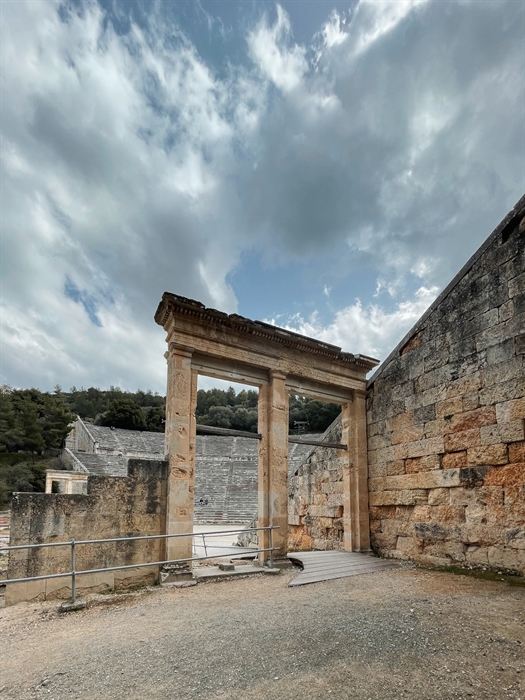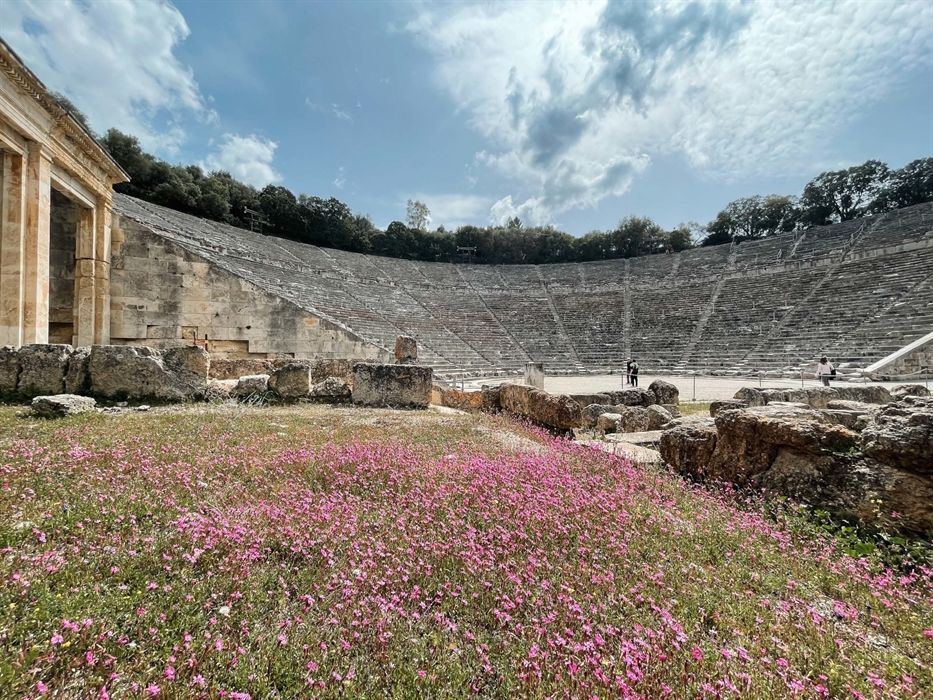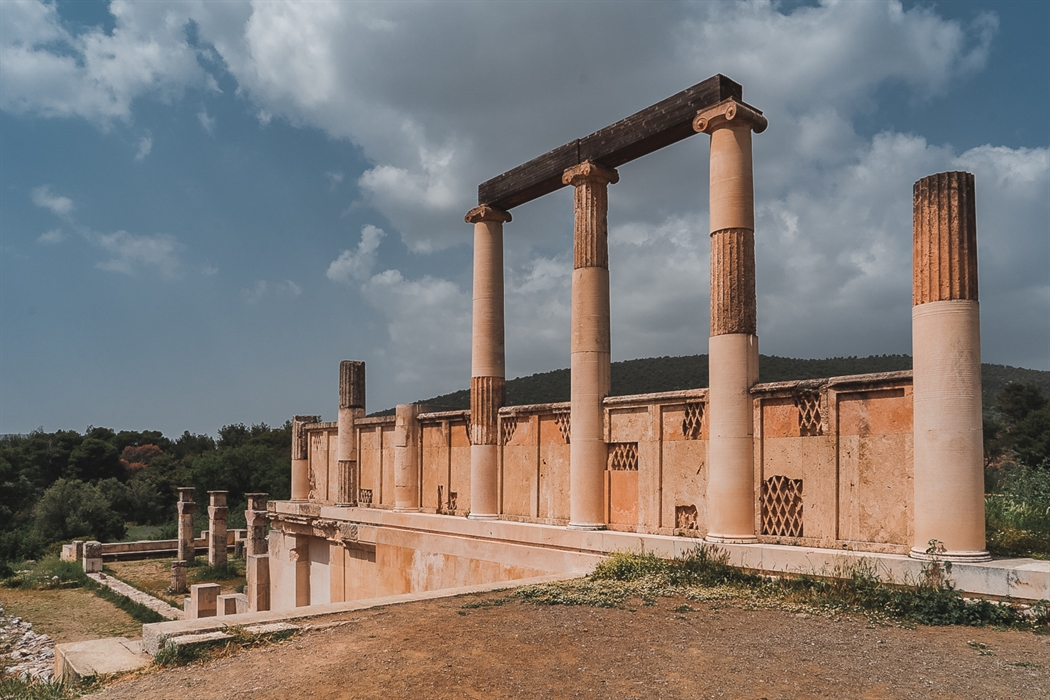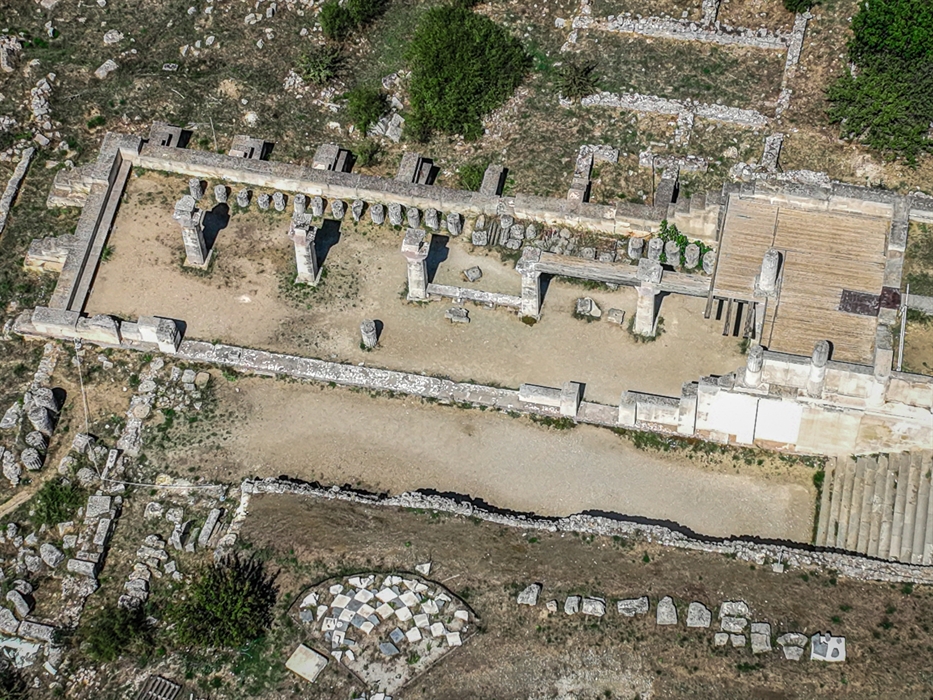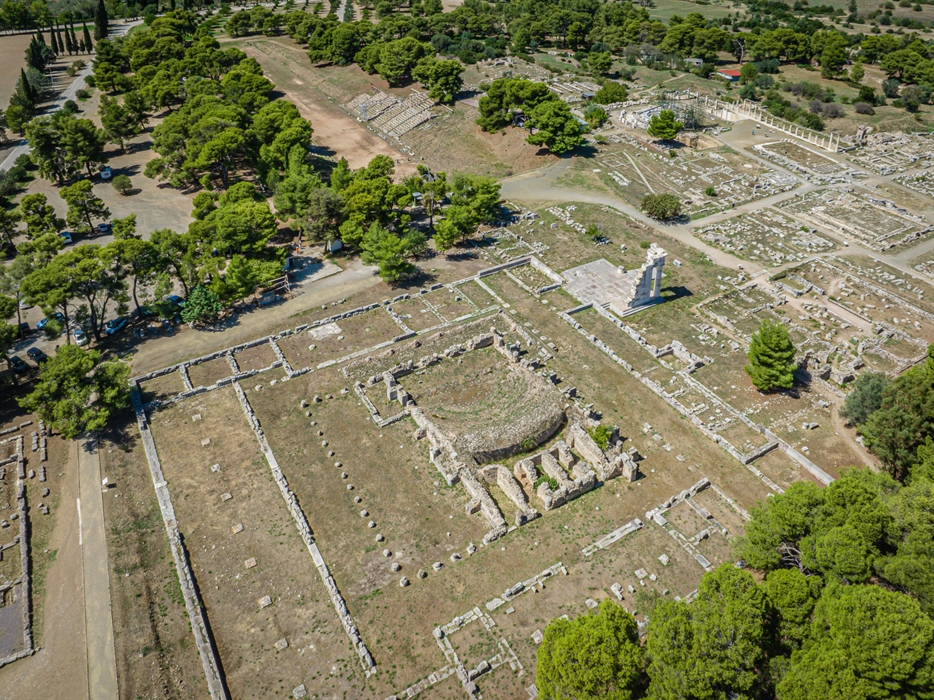The Asklepieion of Epidaurus
The Sanctuary of Asclepius at Epidaurus, a UNESCO World Heritage Site since 1988, was renowned throughout the ancient and Roman world. It was a centre of holistic healing, combining treatments for the soul and the body. The archaeological site includes important monuments, such as the famous ancient theatre of Epidaurus.
A UNESCO World Heritage Site since 1988, the Asklepieion of Epidaurus is the oldest known organized healing centre and gained a huge reputation throughout the ancient Greek and Roman world. The approximately 70 monuments that make up the archaeological site are considered masterpieces of ancient Greek art. Many of these, along with the smaller finds, have given researchers a great deal of information about how medicine was practiced in antiquity. It was here where faith-based healing began to merge with something much more akin to the medicine we know today – a science that evolved through the priests who served the god Asclepius. The healing properties of the water that gushed from the many springs of the area played a key role in the operation of the Asklepieion over the centuries.
The ancient Greek poets Homer and Hesiod describe Asclepius not as a god, but as a mortal and very capable physician. People’s need in the pre-classical age to overcome the distance between the immortal nature of the gods and their own mortality, as well as to overcome illness, led to the mythical symbolism of the healer becoming a god.
The cult and practices of Asclepius spread throughout the Mediterranean. At least 200 thermal centres from Asia Minor to Africa and the Western Mediterranean (including Athens, Piraeus, Rome, etc.) seem to have been directly or indirectly founded by the famous therapeutic centre of Epidaurus.
The history of the Asklepieion at a glance
The cult of health in Epidaurus began on the Kynortion hill in the 16th century BC. In the Mycenaean age, a female deity who was associated with healing was worshipped there. The first sanctuary built on the remains of a settlement of the Early and Middle Bronze Age (2800-1800 BC) was dedicated to her. It was preserved until the 11th century BC. Around 800 BC, it was succeeded by an altar-shrine next to the springs, where Apollo Maleata was honoured. People attributed healing properties to the god, and even called him a doctor. The deity was worshiped at a "common meal" which was taken with him, with sacrifices and communion of the sacred food. The process was called “Theoxenia” (hospitality of the god).
The primitive ritual continued in the sanctuary in the 1st millennium BC. It gained a great reputation and the existing spaces an buildings were not enough to house the ceremonies etc and, in the 8th-7th century BC, the cult was transferred to the plain. A second sanctuary was built there, and operated in parallel with the old one.
In the new sanctuary the healer Apollo was combined with Asclepius, considered by mythology to be the son of Apollo and Coronis, granddaughter of Malos, who was king of Epidaurus. The cult of Asclepius as the healer god was established in the 6th century BC. His sacred animal was the snake and he was chthonic, that is, he healed through the earth.
During the 4th and 3rd centuries BC the Asklepieion was famous and rich, and at that time a large building programme was implemented in both the sanctuary on the plain and the sanctuary on the mountain. The temple of the god, the Avaton, the Tholos, the theatre, the ceremonial restaurant, the Katagogion (guest house) and the stadium were all built at this time. In the theatre and the stadium, drama and athletic games were organised during the great festivals in honour of Asclepius.
After the period of great destruction caused by Syllas and the Cilician pirates (1st century BC), the Asklepieion flourished again in imperial times. In the second half of the 2nd century AD, the Roman senator Antoninus financed the addition of new buildings. At that time, the traveller Pausanias passed by Epidaurus and described the monuments in detail.
In the two following centuries there were disastrous invasions, particularly the invasion of the Goths (267 AD), but in the middle of the 4th century AD the area was reorganised according to Roman standards. The cult continued even after the official prohibition of the ancient religion in 426 AD. The site was finally abandoned after the devastating earthquakes of 522 and 551 AD.
So, what was it like to visit the Asklepieion when it was a flourishing, busy sanctuary, known throughout the Greek and Roman world? First of all, you would have noticed the number of springs and healing waters in the landscape around the temple. Next, you would have undoubtedly been impressed by the Propylon (entrance) and by the site as a whole with its accommodation, hospital buildings, baths, banqueting hall, stadium and, of course, the famous theatre. The temple took a holistic approach to healing, and so before you were admitted to the sacred precinct you had to complete a cleansing process that included fasting, bathing in the Asklepieion Baths and making sacrifices. The preparation and treatment also included exercises, watching artistic events in the theatre (drama therapy) and games in the stadium and reading books in the library. When the big day came and you were ready to be healed, you followed the Sacred Way up to the temple itself where the gold and ivory statue of Asclepius stood.
The actual healing process took place in the abaton, the innermost sanctuary, which patients were forbidden to enter until they were properly prepared and purified. At this point, the priests, possibly by the power of suggestion, would put the patient into “temple sleep”, that is, sleep that was seen as a type of death. During this temple sleep, if all went well, the god would visit the patient and heal them, or tell the priests what to prepare and administer.
In the sanctuary of Asclepius there were many votive offerings depicting the healed limbs of the patients. It seems, however, that the priests not only administered the medicines indicated by the god, but also intervened in the treatment and administered special diets. From the sources which recount the stories of some miracles, human help and even the use of surgery- is evident. Medical instruments and medicine bowls were found during the excavations.
Read about the monuments at the archaeological site.
Asklepieion of Epidaurus - The monuments
There are so many interesting and beautiful remains at the Asklepieion of Epidaurus that it’s difficult to know where to begin. The temple to the god Asclepius, the Avaton (where the patients slept when they were being treated), the Tholos, the theatre, the ceremonial dining rooms, the Katagogion (guest house), the stadium –all these plus the rest of the approximately 70 monuments that comprise the archaeological site of Epidaurus are considered masterpieces of ancient Greek art. Many of these, along with the other archaeological finds, have given researchers a great deal of information about how medicine was practiced in antiquity.
There are two sanctuaries: That of Apollo Maleata and that of Asclepius.
What you will see in the Asklepieion:
The Avaton and the Sanctuary of the god Asclepius. The Avaton Stoa dates back to the 4th century BC. The façade had 31 Ionic columns and between them there were stone railings. The Sanctuary of Asclepius was the main building with which the great building program (380-370 BC) began in the area. It had Doric columns and an internal Corinthian colonnade which housed the gold and ivory statue of Asclepius on a throne with a cane in one hand and a snake in the other. It was described by the traveler Pausanias and was the work of the sculptor Thrasymedes. The exterior of the Avaton was elaborately decorated and the pediments had sculptural reliefs showing themes such as the Fall of Troy and the Battle with the Amazons.
The Tholos (Thymeli) had an underground maze beneath it which was believed to be where the god lived. It is a circular peristyle building which was built between 365-335 BC. and is considered to be the most perfect circular building in ancient Greek architecture.
The ceremonial dining room (late 4th-early 3rd century BC) stands out for its restored monumental propylon that had 6 columns. It was built around a circular courtyard and it was there that the ceremonial meals were held since the cult required that the pilgrims take part in the dinners.
A large guest house - the Katagogion, (late 4th-early 3rd century BC), with 160 rooms for the accommodation of patients and their companions. Remains of bathing facilities are still standing.
The palace, the gymnasium, the conservatory and the stadium where the games in honor of Asclepius were held (it has been restored).
The famous theatre, created to combine the healing of the body with that of the soul through drama therapy. As we all know, it is the most perfect example of a Greek theatre, unique for its the way it is in harmony with the surrounding area, its acoustics and its unparalleled proportions.
In the sanctuary of Apollo Maleata you will see:
The mosque of the Muses, the residence of the priests, the classical altar of Apollo Maleata that has been restored and the great wall.
Read about the history of the Asklepieion.
EXCAVATIONS-RESTORATIONS
When it came to light, the archaeological site of Epidaurus was a large flat area of ruins. The teams of experts wanted to make the site three-dimensional again and chose certain buildings where restoration and renovation works could be carried out. This project is still ongoing. Work has been done on the Avaton stoa, the ceremonial restaurant with its emblematic Propylon and the Tholos, along with some monuments at the sanctuary of Apollo Maleata. Major restoration works were carried out at the Theatre over a period of many years.
Many sections of architectural parts of the buildings can be seen in the Archaeological Museum of Epidaurus, along with sculptures and plaster copies of statues that are in the National Archaeological Museum.
Over the years, an important project of studies, maintenance, restoration and configuration of the two sanctuaries has been implemented.
The first investigations in the Asklepieion of Epidaurus were carried out by the French Scientific Mission of the Peloponnese in 1829. Systematic excavations were carried out by P. Kavvadias, under the auspices of the Archaeological Society of Athens in 1870-1926, revealing the most important monuments of the sanctuary. Limited excavations were carried out by the French School of Athens and the Archaeological Service with I. Papadimitriou in 1948-1951. In 1954-1963, the first restoration works of the theatre were carried out by A. Orlandos.
From 1974 the excavations were again undertaken by the Archaeological Society under the direction of V. Lambrinoudakis at the sanctuary of Apollo Maleata. Works on the preservation and prominence of the monuments of both sanctuaries were carried out by the interdisciplinary team formed by the Ministry of Culture in 1984, and subsequently named the Committee for the Conservation of Epidaurus Monuments. Excavations continue, especially in the area of Tholos.
Location
Find the destination on the interactive map below.
Categories
Weather
Σχετικό περιεχόμενο χρηστών (UGC)
Ενημερωθείτε για ενδιαφέροντα θέματα γύρω από τον προορισμό μέσα από το περιεχόμενο των χρηστών μας
Discover 7 hidden gems of the Peloponnese
Many of you may have already visited some of the most renowned attractions…
TOP 10 archaeological museums in the Peloponnese
Olympia, Mycenae, Epidaurus, Diros Cave, Ancient Corinth, Messene and…
TOP 10 Castles in the Peloponnese
Castles galore! Mystras, Monemvasia, Palamidi, Methoni, Koroni,…
Newsletters
- About us
- FAQ's
- Map
- Tourism information centers
- Disclaimer
- Sitemap
- Our brand
- Media roum
- Adding your bussiness
- Corporate
- MICE

Peloponnese. Greece beyond the obvious





Design and creation from Cosmote
Marinas and Moorings
Diving centers
Get inspired
- Media gallery
- Blog
- The Peloponnese in the media
- Your feedback
- Users' general content
- Users' local products
- Users' events content
- Ask a local
More
- Accommodation
- Travel agencies
- Restaurants
- Services
- Destinations Map
- Weather
- Public transport
- Events
- Frequently asked questions
- Useful phones
- B2B
- Destination Data
- Contact

